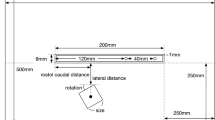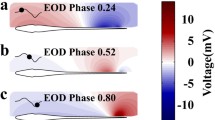Abstract
How might electric fish determine, from patterns of transdermal voltage changes, the size, shape, location, and impedance of a nearby object? I have investigated this question by measuring and simulating electric images of spheres and ellipsoids near an Apteronotus leptorhynchus. Previous studies have shown that this fish's electric field magnitude, and perturbations of the field due to objects, are complicated nonliner functions of distance from the fish. These functions become much simpler when distance is measured from the axes of symmetry of the fish and the object, instead of their respective edges. My analysis suggests the following characteristics of high frequency electric sense and electric images. 1. The shape of electric images on the fish's body is relatively independent of a spherical object's radius, conductivity, and rostrocaudal location. 2. An image's relative width increases linearly with lateral distance, and might therefore unambiguously encode object distance. 3. Only objects with very large dielectric constants cause appreciable phase shifts, and the degree of shift depends strongly on water conductivity. 4. Several parameters, such as the range of electric sense, may depend on the rostrocaudal location of an object. Large objects may be detectable further from the head than the tail, and conversely, small objects may be detectable further from the tail than head. 5. Asymmetrical objects produce different electric images, correlated with their cross-sections, for different orientations and phases of the electric field. 6. The steep attenuation with distance of the field magnitude causes spatial distortions in electric images, somewhat analogous to the perspective distortion inherent in wide angle optical lenses.
Similar content being viewed by others
Abbreviations
- EOD :
-
electric organ discharge
- EO :
-
electric organ
- RMS :
-
root mean square
- p-p :
-
peak-to-peak
- e :
-
eccentricity
References
Bacher M (1983) A new method for the simulation of electric fields generated by electric fish and their distortions by objects. Biol Cybern 47: 51–58
Bastian J (1981) Electrolocation I. How the electroreceptors of Apteronotus albifrons code for moving objects and other electrical stimuli. J Comp Physiol 144: 465–479
Bastian J (1994) Electrosensory organisms. Physics Today 47: 30–37
Bennett MVL (1971) Electroreception. In: Hoar WS, Randall DH (eds) Fish physiology. Academic Press, pp 493–574
Bennett MVL, Shosaku O (1986) Ionic mechanisms and pharmacology of electroreceptors. In: Bullock TH, Heiligenberg W (eds) Electroreception. Wiley & Sons, New York, pp 157–182
Bullock TH and Heiligenberg W (1986) Electroreception. Wiley & Sons, New York
Carr CE (1990) Neuroethology of electric fish. BioScience 40: 259–267
Carr CE, Maler L, Sas E (1982) Peripheral organization and central projections of the electrosensory nerves in gymnotiform fish. J Comp Neurol 211: 139–153
Hagiwara S, Morita H (1963) Coding mechanisms of electroreceptor fibers in some electric fish. J Neurophysiol 26: 551:567
Heiligenberg W (1975) Theoretical and experimental approaches to spatial aspects of electrolocation. J Comp Physiol 103: 247–272
Heiligenberg W (1989) Coding and processing of electrosensory information in Gymnotiform fish. J Exp Biol 146: 255–275
Hopkins CD (1976) Stimulus filtering and electroreception: tuberous electroreceptors in three species of gymnotid fish. J Comp Physiol 111: 171–207
Hoshimiya N, Shogen K, Matsuo T, Chichibu S (1980) The Apteronotus EOD field: waveform and EOD field simulation. J Comp Physiol 135: 283–290
Kalmijn AJ (1986) Detection of weak electric fields. In: Atema J, Fay R, Popper A, Tavolga W (eds) Sensory biology of aquatic animals. Springer, Heidelberg Berlin New York, pp 151–186
Knudsen EI (1974) Behavioral thresholds to electric signals in high frequency electric fish. J Comp Physiol 91: 333–353
Landau LD, Lifshitz EM, Pitaevskii LP (1984) Electrodynamics of continuous media. 2nd Ed., Pergamon Press, Oxford
McKibben JR, Hopkins CD, Yager DD (1993) Directional sensitivity of tuberous electroreceptors: polarity preferences and frequency tuning. J Comp Physiol A 173: 415–424
Nelson ME, Payne JR, Xu Z (1993) Modeling and simulation of primary electrosensory afferent response dynamics in the weakly electric fish, Apteronotus leptorhynchus. J Comp Physiol A 173: 746
Paulin M (1995) Electroreception and the compass sense of sharks. J Theor Biol 174: 325–339
Rasnow B (1994) The electric field of a weakly electric fish. Ph. D. Thesis, California Institute of Technology, University Microfilms
Rasnow B, Bower JM (1995) The electric organ discharges of the Gymnotiform fishes: I. Apteronotus leptorhynchus. J Comp Physiol A (companion paper)
Rasnow B, Assad C, Bower JM (1993) Phase and amplitude maps of the electric organ discharge of the weakly electric fish, Apteronotus leptorhynchus. J Comp Physiol A 172: 481–491
Robinson DA (1968) The electrical properties of metal microelectrodes. Proc IEEE 56: 1065–1071
Rose G, Heiligenberg W (1985) Temporal hyperacuity in the electric sense of fish. Nature 318: 178–180
Scheich H, Bullock TH, Hamstra RH (1973) Coding properties of two classes of afferent nerve fibers: high-frequency electroreceptors in the electric fish, Eigenmannia. J Neurophysiol 36: 39–60
Scheich H, Bullock TH (1974) The detection of electric fields from electric organs. In Fessard A (ed) Handbook of sensory physiology III/3. Springer, Heidelberg Berlin New York, pp 201–256
Shumway CA (1989) Multiple electrosensory maps in the medulla of weakly electric gymnotifrom fish. I. Physiological differences. J Neurosci 9: 4388–4399.
Toerring MJ, Belbenoit P (1979) Motor programmes and electroreception in mormyrid fish. Behav Ecol Sociobiol 4: 369–379
von der Emde G (1993) The sensing of electrical capacitances by weakly electric mormyrid fish: effects of water conductivity. J Exp Biol 181: 157–173
Author information
Authors and Affiliations
Rights and permissions
About this article
Cite this article
Rasnow, B. The effects of simple objects on the electric field of Apteronotus . J Comp Physiol A 178, 397–411 (1996). https://doi.org/10.1007/BF00193977
Accepted:
Issue Date:
DOI: https://doi.org/10.1007/BF00193977




